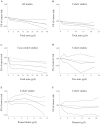Association of Total Nut, Tree Nut, Peanut, and Peanut Butter Consumption with Cancer Incidence and Mortality: A Comprehensive Systematic Review and Dose-Response Meta-Analysis of Observational Studies
- PMID: 33307550
- PMCID: PMC8166551
- DOI: 10.1093/advances/nmaa152
Association of Total Nut, Tree Nut, Peanut, and Peanut Butter Consumption with Cancer Incidence and Mortality: A Comprehensive Systematic Review and Dose-Response Meta-Analysis of Observational Studies
Abstract
Data on the association of nut intake with risk of cancer and its mortality are conflicting. Although previous meta-analyses summarized available findings in this regard, some limitations may distort their findings. Moreover, none of these meta-analyses examined the dose-response associations of total nut intake with the risk of specific cancers as well as associations between specific types of nuts and cancer mortality. Therefore, this study aimed to summarize available findings on the associations of total nut (tree nuts and peanuts), tree nut (walnuts, pistachios, macadamia nuts, pecans, cashews, almonds, hazelnuts, and Brazil nuts), peanut (whole peanuts without considering peanut butter), and peanut butter consumption with risk of cancer and its mortality by considering the above-mentioned points. We searched the online databases until March 2020 to identify eligible articles. In total, 43 articles on cancer risk and 9 articles on cancer mortality were included in the current systematic review and meta-analysis. The summary effect size (ES) for risk of cancer, comparing the highest with lowest intakes of total nuts, was 0.86 (95% CI: 0.81, 0.92, P < 0.001, I2 = 58.1%; P < 0.01), indicating a significant inverse association. Such a significant inverse association was also seen for tree nut intake (pooled ES: 0.87, 95% CI: 0.78-0.96, P < 0.01, I2 = 15.8%; P = 0.28). Based on the dose-response analysis, a 5-g/d increase in total nut intake was associated with 3%, 6%, and 25% lower risks of overall, pancreatic, and colon cancers, respectively. In terms of cancer mortality, we found 13%, 18%, and 8% risk reductions with higher intakes of total nuts, tree nuts, and peanuts, respectively. In addition, a 5-g/d increase in total nut intake was associated with a 4% lower risk of cancer mortality. In conclusion, our findings support the protective association between total nut and tree nut intake and the risk of cancer and its mortality.
Keywords: cancer; meta-analysis; mortality; nuts; peanuts.
© The Author(s) 2020. Published by Oxford University Press on behalf of the American Society for Nutrition.
Figures





Similar articles
-
Nut consumption and type 2 diabetes risk: a systematic review and meta-analysis of observational studies.Am J Clin Nutr. 2021 Apr 6;113(4):960-971. doi: 10.1093/ajcn/nqaa358. Am J Clin Nutr. 2021. PMID: 33471083
-
Relationship of tree nut, peanut and peanut butter intake with total and cause-specific mortality: a cohort study and meta-analysis.Int J Epidemiol. 2015 Jun;44(3):1038-49. doi: 10.1093/ije/dyv039. Epub 2015 Jun 11. Int J Epidemiol. 2015. PMID: 26066329
-
Association between nut consumption and prostate cancer risk in adults: A systematic review and dose-response meta-analysis of observational studies.Nutr Metab Cardiovasc Dis. 2023 Jul;33(7):1293-1307. doi: 10.1016/j.numecd.2023.04.004. Epub 2023 Apr 10. Nutr Metab Cardiovasc Dis. 2023. PMID: 37160404
-
Total Nut, Tree Nut, Peanut, and Peanut Butter Consumption and the Risk of Pancreatic Cancer in the Netherlands Cohort Study.Cancer Epidemiol Biomarkers Prev. 2018 Mar;27(3):274-284. doi: 10.1158/1055-9965.EPI-17-0448. Epub 2018 Jan 22. Cancer Epidemiol Biomarkers Prev. 2018. PMID: 29358224
-
Nut and peanut butter consumption and the risk of lung cancer and its subtypes: A prospective cohort study.Lung Cancer. 2019 Feb;128:57-66. doi: 10.1016/j.lungcan.2018.12.018. Epub 2018 Dec 18. Lung Cancer. 2019. PMID: 30642454
Cited by
-
Nuts and Older Adults' Health: A Narrative Review.Int J Environ Res Public Health. 2021 Feb 14;18(4):1848. doi: 10.3390/ijerph18041848. Int J Environ Res Public Health. 2021. PMID: 33672861 Free PMC article. Review.
-
Pro-Inflammatory Food, Gut Microbiota, and Cardiovascular and Pancreatic Diseases.Biomolecules. 2024 Feb 10;14(2):210. doi: 10.3390/biom14020210. Biomolecules. 2024. PMID: 38397447 Free PMC article. Review.
-
A Slight Adjustment of the Nutri-Score Nutrient Profiling System Could Help to Better Reflect the European Dietary Guidelines Regarding Nuts.Nutrients. 2022 Jun 27;14(13):2668. doi: 10.3390/nu14132668. Nutrients. 2022. PMID: 35807847 Free PMC article.
-
Antioxidant and Anti-Inflammatory Properties of Walnut Constituents: Focus on Personalized Cancer Prevention and the Microbiome.Antioxidants (Basel). 2023 Apr 22;12(5):982. doi: 10.3390/antiox12050982. Antioxidants (Basel). 2023. PMID: 37237848 Free PMC article. Review.
-
The Effects of Almond Consumption on Inflammatory Biomarkers in Adults: A Systematic Review and Meta-Analysis of Randomized Clinical Trials.Adv Nutr. 2022 Oct 2;13(5):1462-1475. doi: 10.1093/advances/nmab158. Adv Nutr. 2022. PMID: 34967837 Free PMC article.
References
-
- Ferlay J, Steliarova-Foucher E, Lortet-Tieulent J, Rosso S, Coebergh JW, Comber H, Forman D, Bray F. Cancer incidence and mortality patterns in Europe: estimates for 40 countries in 2012. Eur J Cancer. 2013;49(6):1374–403. - PubMed
-
- Fitzmaurice C, Allen C, Barber RM, Barregard L, Bhutta ZA, Brenner H, Dicker DJ, Chimed-Orchir O, Dandona R, Dandona Let al. . Global, regional, and national cancer incidence, mortality, years of life lost, years lived with disability, and disability-adjusted life-years for 32 cancer groups, 1990 to 2015: a systematic analysis for the global burden of disease study. JAMA Oncol. 2017;3(4):524–48. - PMC - PubMed
-
- Lortet-Tieulent J, Soerjomataram I, Lin CC, Coebergh JWW, Jemal A. U.S. burden of cancer by race and ethnicity according to disability-adjusted life years. Am J Prev Med. 2016;51(5):673–81. - PubMed
-
- Parohan M, Sadeghi A, Khatibi SR, Nasiri M, Milajerdi A, Khodadost M, Sadeghi O. Dietary total antioxidant capacity and risk of cancer: a systematic review and meta-analysis on observational studies. Crit Rev Oncol Hematol. 2019;138:70–86. - PubMed
-
- Nachvak SM, Moradi S, Anjom-Shoae J, Rahmani J, Nasiri M, Maleki V, Sadeghi O. Soy, soy isoflavones, and protein intake in relation to mortality from all causes, cancers, and cardiovascular diseases: a systematic review and dose-response meta-analysis of prospective cohort studies. J Acad Nutr Diet. 2019;119(9):1483–500.e17. - PubMed

